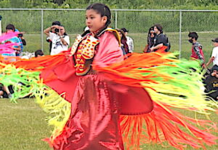
Today, June 21st, is not only the summer solstice and the longest day of the year, it is also recognized as National Indigenous Peoples Day. This year marks a significant milestone as it is the 25th anniversary of National Indigenous Peoples Day known formerly as National Aboriginal Day.
According to Government records, “National Aboriginal Day (now National Indigenous Peoples Day) was announced in 1996 by then Governor General of Canada, Roméo LeBlanc, through the Proclamation declaring June 21st of each year as National Aboriginal Day and, on On June 21, 2017, Prime Minister Justin Trudeau issued a statement announcing the intention to rename this day National Indigenous Peoples Day.”
‘Indigenous Peoples’ is a collective name that refers to original peoples globally and their descendants. In Canada, the Constitution recognizes three distinct groups as Aboriginal or Indigenous peoples – First Nations, Métis and Inuit, each having unique languages, cultural practices, histories and spiritual beliefs.
According to the 2016 census, more than 1.67 million people in Canada identify themselves as Aboriginal or Indigenous.
In Canada, there are more than 630 First Nation communities representing more than 50 Nations and 50 Indigenous languages. Close to home in Bruce County, the Chippewas of Saugeen First Nation and the Chippewas of Nawash Unceded First Nation (Cape Croker) make up the Saugeen Ojibway Nation (SON).
In Saugeen Shores, the two communities of Southampton and the adjacent Saugeen First Nation Reserve #29, are working together to become connected. One of the largest celebrations was on June 21st (2018), Indigenous People’s Day, when the two communities came together in an historic moment. Bruce County Museum and Cultural Centre also celebrated First Nations when it opened the First Nations Gallery in 2018 and hosted Voices of Chief’s Point exhibit in 2019.
Unfortunately, history of the First Nations, Residential Schools and the Truth and Reconciliation Report have shown us that there were many things done to the First Nations peoples that have marred the history of the country and impacted the indigenous peoples for generations.
In 2020, the United Church of Canada presented a video on the History of the First Nations People and also apologized for its role in the Residential Schools, whereby the government forcibly removed children from their homes in an authoritarian attempt to assimilate them into the Colonial (Caucasian) way of life. It’s a history that has scarred the lives of many First Nations generations.
The Métis are also one of the three recognized Aboriginal peoples in Canada. As early traders and fishermen, the Métis played an integral role in the settlement of Southampton and Bruce County along the Lake Huron shoreline and, in 2018, they celebrated the 200th anniversary of the Historic Saugeen Métis. According to the 2011 National Household Survey, 418,380 Canadians self-identified as Métis.
The Inuit with their long history are the Indigenous peoples of the Arctic. The word Inuit means “the people” in the Inuit language of Inuktitut. Inuit, both early and today, have always relied for sustenance on the harvest of marine mammals throughout the year. With the exception of southernmost Labrador, all of the territory used by present-day Inuit and by the Inuit who came before, has remained almost the same, generation after generation.
While COVID-19 has impacted the many Indigenous celebrations that would have normally occurred on Indigenous Peoples Day, it is still a time to remember, honour and learn about the indigenous peoples of Canada.











